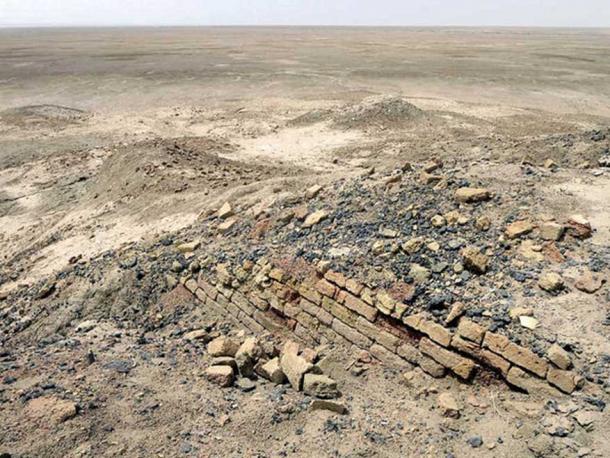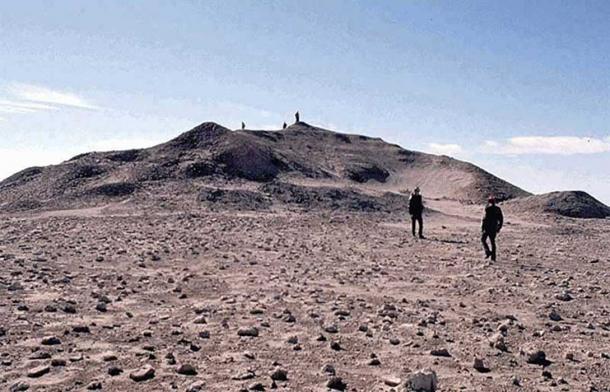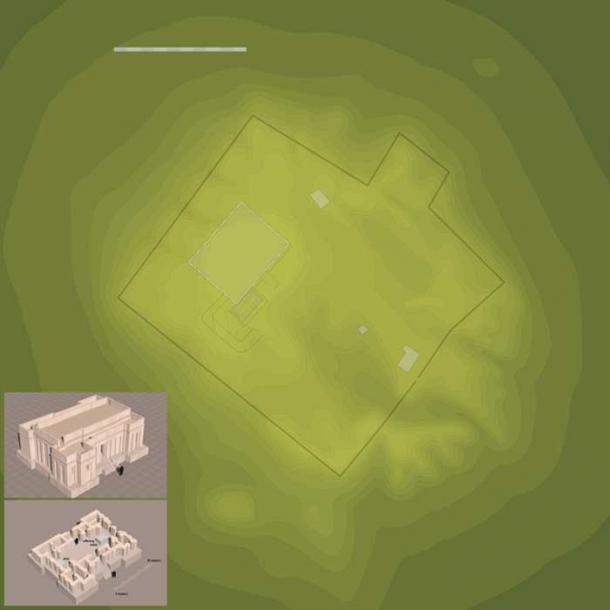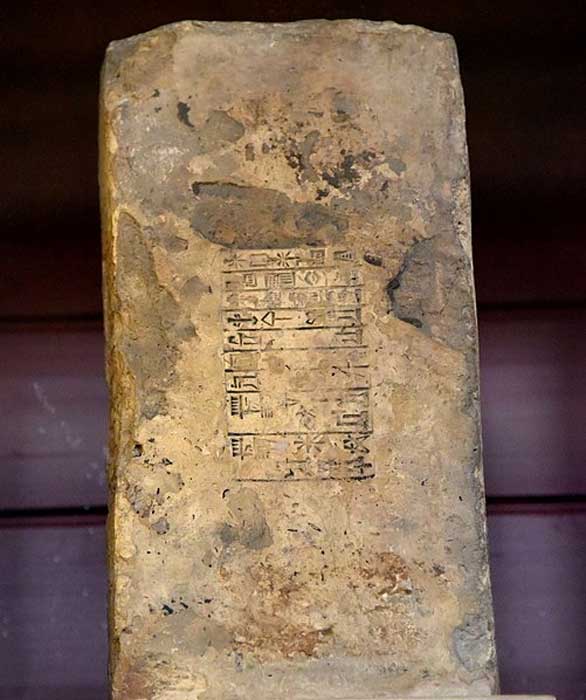
Eridu: The Sumerian Garden of Eden and the Oldest City in the World?
Today, Eridu is often considered to be one of the oldest permanent settlements in Mesopotamia, and perhaps even in the world. The ancient Sumerians also believed that Eridu was the first city in the world and they documented that belief in the Sumerian King List and the Eridu Genesis. At least 18 layers of settlement are found at the site, could the ancient Sumerian belief be possible?
Archaeological evidence shows that the earliest structures date to the 6th millennium BC. The city reached its zenith during the 4th millennium BC and continued to be inhabited until around the 7th century BC. By then, however, the city had lost its importance.

Some of the baked bricks used in the construction of the Sumerian ziggurat at Eridu, southwest of Nasiriyah, Iraq, are stamped with the name of King Ur-Nammu (2123-2106 BC). (David Stanley/CC BY 2.0)
A Tell of 18 Levels
Eridu (known today as Tell Abu Shahrain) is located about 20 km (12.5 miles) to the southwest of the famous city of Ur. As its modern name indicates, the archaeological site is a tell, which is a huge mound formed over the millennia as a result of new settlements being built over the ruins of the previous ones. The tell rises to a height to 7 meters (23 feet), and is formed by 18 levels of occupation, according to the archaeological excavations. The bulk of this has been dated to the Ubaid and Uruk periods, which lasted from the 6th to 4th millennia BC.
- What Was Life Like in Sumer, History’s First Civilization?
- The Unanswered Mystery of 7,000-year-old Ubaid Lizardmen
- The ‘Dynastic Race’ and the Biblical ‘Japheth’ – Part I: After the Deluge

The ruins of Eridu in 2011. (Ltybcc1/CC BY SA 3.0)
The ancient Sumerians themselves made mention of Eridu’s antiquity. In the Sumerian King List, for example, it is written that “After the kingship descended from heaven, the kingship was in Eridug.” In addition, in the creation myth known as the Eridu Genesis, it is said to have been one of the five cities that existed before the Deluge, the others being Bad-Tibira, Larak, Sippar, and Suruppak.
The God of Eridu Temple
The patron god of Eridu was Enki (known also in Akkadian as Ea), the god of water. According to Sumerian mythology, the settlement was founded by Enki, and it was from this city that civilization was spread to other parts of the land. Although Enki was initially a local god, he rose in importance as the city grew in influence, resulting in him being incorporated into the pantheon of other cities as well. In Eridu, Enki’s temple is known as E-Abzu (Abzu may be translated as ‘Deep Ocean’, and refers to the underground spring from which all life is believed to have begun).

Rough map of the Eridu mound showing the main ziggurat, temple, and a few buildings. (Cush/CC BY SA 3.0)
Archaeological excavations of the E-Abzu have revealed that the temple began as a small room containing what has been referred to by scholars as a ‘cult niche’ and an ‘offering table’. Over the millennia, however, the inhabitants built new temples over the ruins of the old ones, each bigger than the last. The E-Abzu eventually became a large ziggurat, an apt reflection of Enki’s status as a major deity. It has been proposed that the E-Abzu may have been the largest of the ancient Mesopotamian ziggurats.
Economic Activities
Although the E-Abzu is the focal point of the site’s archaeology, there are either elements of interest. More recent excavations, for instance, have revealed that during the Ubaid period, the city was a pottery production center. This is evident in the pottery works, which had large scatterings of pottery fragments and kiln waste. Additionally, remains of fishing nets, weights, and even models of reed boats have been found at the site, suggesting that fishing was a major economic activity carried out by the inhabitants.

There are nine lines of cuneiform inscriptions on this fired clay brick; stamp of the king Amar-Sin (Amar-Suen, previously misread as Bur-Sin), king of Ur. 2100-2000 BC. From Eridu (modern-day Tell Abu Shahrain), southern Mesopotamia, Iraq. It is currently housed in the British Museum in London. (Osama Shukir Muhammed Amin FRCP(Glasg)/CC BY SA 4.0)
Eridu was the dominant city in southern Mesopotamia during the Ubaid period, but it was eventually superseded by Uruk. Nevertheless, it continued to be revered as the first city, and it retained its religious significance thanks to the E-Abzu.
- Nammu: A Forgotten Tale of the Sumerian Mother of Gods
- The Royal Road of the King of the World, and the Ancient Center of the Earth
- The Powerful Enki: Epic Sumerian, Babylonian, and Akkadian Deity
It has been suggested that ecological changes, i.e. the recession of the gulf coast and the increasingly unreliable water table, were responsible for the decline of Eridu around the end of the 3rd millennium BC. The city continued to be inhabited up until around the 7th century BC, although by then it had become a mere shadow of its former glory.
In 2016, Eridu was inscribed as a UNESCO World Heritage Site, as part of the ‘Ahwar of Southern Iraq: Refuge of Biodiversity and the Relict Landscape of the Mesopotamian Cities’.
Top image: Re-creation of the port at Eridu. Source: Public Domain
By: Wu Mingren
References
Anon., The Flood Story [The Electronic Text Corpus of Sumerian Literature, Faculty of Oriental Studies, University of Oxford (trans.), 2003. The Flood Story.] Available at: http://etcsl.orinst.ox.ac.uk/cgi-bin/etcsl.cgi?text=t.1.7.4#
Anon., The Sumerian King List [The Electronic Text Corpus of Sumerian Literature, Faculty of Oriental Studies, University of Oxford (trans.), 2001. The Sumerian King List.] Available at: http://etcsl.orinst.ox.ac.uk/section2/tr211.htm
Hirst, K. K., 2017. Eridu (Iraq): The Earliest City in Mesopotamia and the World. Available at: https://www.thoughtco.com/eridu-iraq-earliest-city-in-mesopotamia-170802
The Editors of Encyclopaedia Britannica, 2016. Eridu. Available at: https://www.britannica.com/place/Eridu
theancientneareast.com, 2014. Eridu and the First Cities. Available at: http://theancientneareast.com/eridu-and-the-first-cities/
UNESCO, 2018. The Ahwar of Southern Iraq: Refuge of Biodiversity and the Relict Landscape of the Mesopotamian Cities.Available at: https://whc.unesco.org/en/list/1481
www.ancient-wisdom.com, 2018. Eridu. Available at: http://www.ancient-wisdom.com/iraqeridu.htm
www.crystalinks.com, 2018. Eridu. Available at: http://www.crystalinks.com/eridu.html
















Comments
If you consider that the Sumerians had a clay brick culture from their very start (there is no mention in any Sumerian text on the cutting and use of large quarry stones), the explanations and dating fall down hard. Clay bricks can only rise so high before they collapse under their own weight – just three stories would be taking a big chance. So where they say there are “18 levels of occupation, according to the archaeological excavations”, they must be referring to subterranean stone masonry (aka basement foundation), which the Sumerians are NOT associated with. Like many other sites, this one is also almost certainly the work of the Atlantean era culture that was decimated at the start of the Ice Age circa 115k BC (adding the zero back to Plato's timeline). Prior to the Ice Age, there were NO ice caps and thus seas were hundreds of feet higher, which was have made Eridu an Atlantis-like (Richat) structure, i.e., island within an inland sea.
Nobody gets paid to tell the truth.
The Bible has God warning Adam NOT TO EAT OR HE WILL DIE, of the tree of knowledge of good and evil in EDEN. The Sumerian equivalent has the god of Eridu, Enki, warning his servant Adaba (Babylonian Adapa) NOT TO EAT OR HE WILL DIE, of the bread of death, to be offered him in Anu's heavenly abode by Ningishzida and Dumuzid, on Anu's behalf. I understand that Eridu, where the warning was given man by his god, was recast in Genesis as Yahweh warning Adam DO NOT EAT. Ergo, ERidu is the earthly pre-biblical location behind Genesis' Garden in EDEN. Hebrew EDEN translates as DELIGHT, whereas Sumerian EDIN translates as a "desert plain" (modern Iraq). I have written two books on the subject in 2010, available at Amazon.com, (1) Eden's Serpent: Its Mesopotamian Origin and (2) The Garden of Eden Myth: Its Pre-biblical Origin in Mesopotamian Myths. A polytheistic EDIN has been recast into a monotheistic Eden in Genesis. Every Sumerian city had a god's fruit-tree garden, planted to provide food for the god to consume. So there were MANY gods' gardens in EDIN, whereas the Hebrews and their ONE GOD, had only ONE garden in Eden.
Kitnkaat noted that Wu Mingren (alias DHWTY) had failed to establish why he thought Eridu might be the Garden of Eden. She is correct. My research agrees, however, to a degree, with DHWTY’s assertion, Eridu is indeed behind the Bible’s Garden of Eden. I understand that Genesis’ Garden of Eden account is an ANTI-THESIS, in response to and in refutation of, an earlier Mesopotamian THESIS, regarding the origins of man. Where he was created, when, why, and by whom? In one Sumerian and later Babylonian myth, Man is being created of EDIN’S clay, which is over the Apsu at Eridu. The god of Eridu, Sumerian Enki, Babylonian EA, dwells in a subterranean ocean, the Abzu/Apsu. He creates man to relieve the Igigi gods of toil in his garden of EDIN at Eridu. Poems praise Enki and speak of him creating a fruit-tree garden, and he is described as being like an ushumgal, standing in the garden’s midst. An ushumgal is a Sumerian dragon, an epithet given Enki in several poems. The ushumgal had four legs, two wings, two horns, and a serpentine body, with sharp teeth that delivered a poisonous bite. Thus Eridu’s ushumgal, Enki, was man’s creator in one Mesopotamian myth. He created man to end a revolt among the junior gods, the Igigi, who objected to the back-breaking work in clearing irrigation ditches feeding the fruit-tree garden at Eridu of clogging sediments. Man is created to replace the Igigi. Now the junior gods can rest from physical gardening toil like the senior gods, the Annunaki. This is presented in a somewaht similar story of the god Enlil at Nippur (man being created to replace the rebel Igigi gods who object to toil in EDIN’S garden at Nippur). Every Sumerian city had a god’s garden that man worked on the god’s behalf, alleviating the gods of gardening toil. So, in pre-biblical myths, there were many gods’ gardens in the EDIN. All this is refuted in Genesis, there is only one God, Yahweh-Elohim, and thus there is by default, only one garden in EDEN. Because Eridu is the first city in Mesopotamian myths, it becomes the model for all the later cities and their gods’ city-gardens of fruit trees that man cares for on the gods’ behalf. My two books cover all this in greater depth, written in 2010, and available on the internet from several book sellers, (1) The Garden of Eden Myth: Its Pre-biblical Origin in Mesopotamian Myths, and (2) Eden’s Serpent: Its Mesopotamian Origin. I also have website, www.bibleorigins.net that I have posted this research to, just google “mattfeld, garden of Eden,” for more info.
Walter R. Mattfeld
In Sumerian myths the gods dwell in a location called the EDIN, it is uncultivated wilderness, today's desert wastelands of Iraq. The gods build cities to dwell in. They possess bodies of flesh and can die of starvation if they have no food to eat so they create city fruit-tree gardens in the midst of the EDIN. Tiring of the back-breaking labor in removing clogging sediments from the irrigation canals, the gods create man to relieve themselves of this toil. Man will clear the sediments, man will harvest the produce and present it to the gods to consume in temple sacrifices as food offerings. Twice a day, morning and evening, the gods are fed at the Temples, just as the Hebrew God Yahweh-Elohim is fed twice a day, morning and evening, by the Levitical priests at the Temple of Solomon in Jerusalem. Every Sumerian city had its god, and its god's city-garden of fruit trees, for the purpose of feeding the gods. Genesis refutes all this, there is only one god, and so there is only one god's garden of fruit-trees in EDEN. God made the garden to feed man, not God, as in the Sumerian myths. Because Eridu, in myth, is the first city, it becomes the prototype for all the other Sumerian cities' gods' gardens in the midst of the EDIN. See my book published in 2010 and available at Amazon.com for more details, _The Garden of Eden Myth: Its Pre-Biblical Origin in Mesopotamian Myths.
Walter R. Mattfeld
I’m very interested in Mesopotamian history and I appreciate your diligent research and copious references. However, I fail to see how Eridu is a “Garden of Eden.” your article only recounts its existence as one of five cities before the deluge